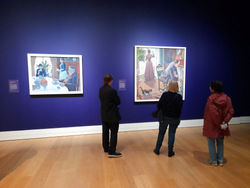
Research from the Institute of Psychiatry, Psychology & Neuroscience (IoPPN) at King’s College London, suggests that viewing original works of art in a gallery setting can reduce key saliva markers associated with stress and chronic disease.
Fifty volunteers aged 18-40 were recruited from staff and students at Kings College. Half the group spent twenty minutes viewing original artworks at The Courtauld Gallery in London. The other half viewed reproductions of the same paintings in a matched, non-gallery environment. Participants were monitored for heart rate variability and skin temperature using digital watches to track levels of interest and arousal. Saliva samples were collected before and after viewing.
Levels of cortisol, a key stress hormone, fell by an average of 22% in the gallery group, compared to 8% in the reproduction group. Those viewing original art also had more dynamic heart activity, indicating that art engages the body through both emotional arousal and stress regulation.
Pro-inflammatory cytokines (IL-6 and TNF-alpha), which are linked to stress and a number of chronic diseases, dropped by around 28% for those viewing original art, while no change was observed in the reproduction group. This suggests art has a potential calming effect on the body’s inflammatory responses.
Dr Tony Woods, the study’s senior author from King’s IoPPN said, “Our unique and original study provides compelling evidence that viewing art in a gallery is ‘good for you’ and helps to further our understanding of its fundamental benefits. In essence, art doesn’t just move us emotionally — it calms the body too. Stress hormones and inflammatory markers like cortisol, IL-6 and TNF-alpha are linked to a wide range of health problems, from heart disease and diabetes to anxiety and depression. The fact that viewing original art lowered these markers suggests that cultural experiences may play a real role in protecting both mind and body.”
(The Physiological Impact of Viewing Original Artworks vs. Reprints:
A Comparative Study. Institute of Psychiatry, Psychology and Neuroscience, Department of Psychological Medicine, King’s College London. Kings College News Centre, accessed 28 October 2025.)
